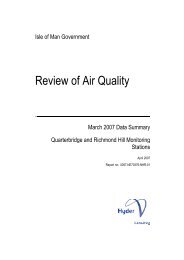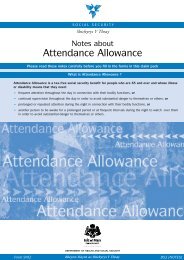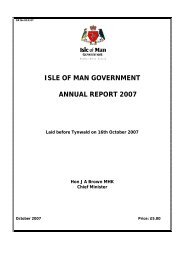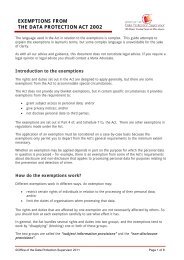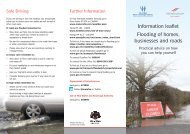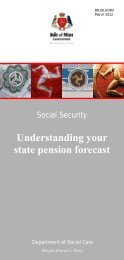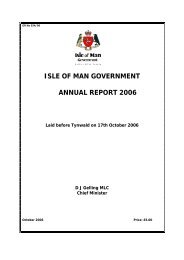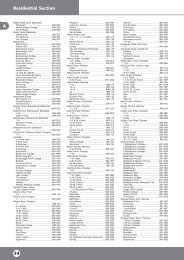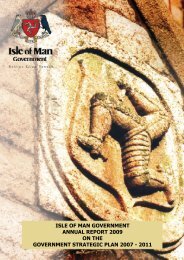Cowes of the North - Isle of Man Government
Cowes of the North - Isle of Man Government
Cowes of the North - Isle of Man Government
You also want an ePaper? Increase the reach of your titles
YUMPU automatically turns print PDFs into web optimized ePapers that Google loves.
Provided that facilities are put in place, strategic partnerships would be a very good way <strong>of</strong><br />
developing marine events, for example with <strong>the</strong> Combined Clubs <strong>of</strong> Dun Laoghaire. These<br />
have world-class regatta and race organising experience, but are somewhat limited by <strong>the</strong><br />
opportunities <strong>of</strong> Dublin Bay.<br />
More broadly, <strong>the</strong> sea around <strong>the</strong> Island is one <strong>of</strong> its greatest attributes, and yet it is hard to<br />
find this referenced in government thinking. When <strong>the</strong> Strategic Plan is adopted, it will be<br />
enacted via four area plans, which will frame <strong>the</strong> spatial and economic policy context for <strong>the</strong><br />
Island. It is important that <strong>the</strong>se plans are framed with <strong>the</strong> sea as an integral part <strong>of</strong> <strong>the</strong><br />
Island’s resource.<br />
The <strong>Isle</strong> <strong>of</strong> <strong>Man</strong> might learn some lessons from <strong>the</strong> Republic <strong>of</strong> Ireland, which set up <strong>the</strong><br />
Marine Institute in 1991 to “assess and realise <strong>the</strong> economic potential <strong>of</strong> Ireland's 220 million<br />
acre marine resource” (i.e. <strong>the</strong> sea).<br />
Discussions with <strong>the</strong> Tourism Department suggest that an interdepartmental collaborative<br />
project to develop a cohesive marine strategy would be welcome. This would provide <strong>the</strong><br />
vision and basis for fusion <strong>of</strong> economic, business, leisure, and tourism opportunities <strong>of</strong>fered<br />
by <strong>the</strong> sea. For example, <strong>the</strong> Island <strong>of</strong>fers good opportunities for more marine ecology based<br />
tourism and sports diving.<br />
4.2 Assessment Methodology<br />
The potential benefits <strong>of</strong> expanding <strong>the</strong> sector are:<br />
♦ More direct and indirect revenue in marinas and <strong>the</strong> supply chains developing around <strong>the</strong>m.<br />
♦ Employment in marinas and <strong>the</strong> attendant supply chain.<br />
♦ More people from outside <strong>the</strong> Island keeping boats on <strong>the</strong> Island.<br />
♦ More people visiting <strong>the</strong> Island as tourists by boat.<br />
♦ Adding to <strong>the</strong> tourist <strong>of</strong>fer in relevant towns and improving <strong>the</strong> general image <strong>of</strong> towns.<br />
♦ More spend by Islanders retained on <strong>the</strong> Island.<br />
The methodology for determining <strong>the</strong> economic impact <strong>of</strong> <strong>the</strong> maritime sector is based on a<br />
Keynesian multiplier approach. There are three main ways in which an investment or a level<br />
<strong>of</strong> economic activity has an impact:<br />
4.2.1 Direct Impact<br />
This is <strong>the</strong> initial impact made by companies who are directly involved in <strong>the</strong> marine leisure<br />
sector in <strong>the</strong> <strong>Isle</strong> <strong>of</strong> <strong>Man</strong>, i.e. those businesses that would be directly affected to some<br />
degree if <strong>the</strong> marinas were not <strong>the</strong>re. This also includes <strong>the</strong> revenue to <strong>Isle</strong> <strong>of</strong> <strong>Man</strong> Harbours<br />
from berth charges.<br />
4.2.2 Indirect Impact<br />
Businesses involved in <strong>the</strong> maritime sector in turn inject money into <strong>the</strong> economy through<br />
spending on goods and services, and this generates an indirect impact. We use multipliers to<br />
estimate <strong>the</strong> size <strong>of</strong> this indirect impact. The size <strong>of</strong> <strong>the</strong> multipliers and <strong>the</strong> impact on <strong>the</strong><br />
local economy, however, depend on <strong>the</strong> extent to which <strong>the</strong>se goods and services are<br />
sourced locally, i.e. <strong>the</strong> strength <strong>of</strong> <strong>the</strong> supply chain linkages, and <strong>the</strong> definition <strong>of</strong> <strong>the</strong> local<br />
economy.<br />
28


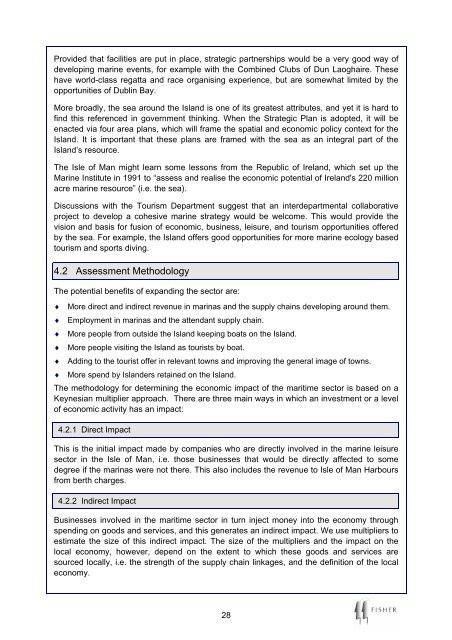
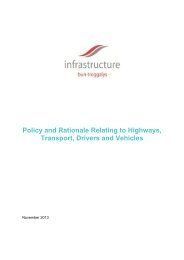
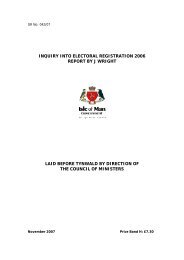
![Smeaton v Equifax CA[2013] EWCA Civ 108](https://img.yumpu.com/22052507/1/184x260/smeaton-v-equifax-ca2013-ewca-civ-108.jpg?quality=85)

